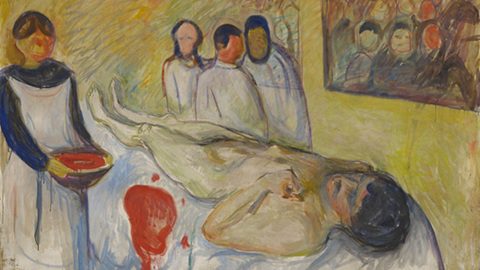 In 2025, MUNCH offers a spectacular range of exhibitions, activities and experiences for young and adult art enthusiasts. The museum challenges the senses, touches the heart, and engages with themes of life and death, dramatic turning points in the world, and ongoing societal debates on war, the green transition, and artificial intelligence.
In 2025, MUNCH offers a spectacular range of exhibitions, activities and experiences for young and adult art enthusiasts. The museum challenges the senses, touches the heart, and engages with themes of life and death, dramatic turning points in the world, and ongoing societal debates on war, the green transition, and artificial intelligence.
The year kicks off with two powerful contrasts from Germany, as MUNCH opens the season with Feet First, the largest exhibition of Georg Baselitz ever shown in Norway. Afterwards, visitors can be captivated by the challenging universe of Kerstin Brätsch, an artist from the generation following Baselitz, who confronts the very essence of what a painting is, through large installations composed of different media.
– I am proud to invite everybody to a year that will inspire, challenge, and bring people together, while also stimulating critical thinking and offering new perspectives on our global era, says MUNCH Director Tone Hansen.
A Space for All
Kiyoshi Yamamoto’s You Are What You Is opens on 5 April. In Yamamoto’s colourful, playful exhibition for children, the artist encourages us to rethink who we are and celebrates breaking boundaries. You Are What You Is makes art accessible by creating a space that embraces people as a whole and fosters a sense of community. Kiyoshi Yamamoto is the fourth artist in our series of exhibitions for children, Come Think With Us!.
Feel Munch’s Pulse
This summer, Lifeblood re-examines Munch’s life through the development of modern medicine, from the late 1800s to the 1940s. Munch’s art, which he called his ‘lifeblood’, reflects the profound changes in medical treatment that occurred during his lifetime. The exhibition offers a unique critical perspective on illness and modern healthcare by placing his artworks next to historical medical artefacts. The exhibition offers thought-provoking perspectives on care, bodily vulnerability, and the healing promise of medicine.
Autumn Highlights: From Holograms to Modernism
Autumn at MUNCH starts with Lawrence Abu Hamdan’s solo exhibition Zifzafa, a new sound installation where visitors can hear the impact that planned wind turbines would have on people’s lives in the occupied Golan Heights. This work questions who bears the consequences of the green transition and how it affects local communities, a theme particularly relevant given the debates around Norwegian wind power.
The second edition of the MUNCH Triennial – Almost Unreal – boots up in the autumn, featuring over 20 contemporary artists exploring the spaces between the real and the virtual. Old and new technologies, dystopian and hopeful visions of the future, video games, holograms, sculptures, and textiles will all be showcased.
Toward the end of the year, we revisit Norwegian modernist Ludvig Karsten’s colourful palette and artistry. This exhibition brings fresh perspectives on an artist central to Norwegian art history who has received little attention in recent times, offering an intimate encounter with Karsten’s art and the breadth of his work.
Children and Youth at the Centre
The keywords for MUNCH’s youngest visitors in 2025 are painting and joy of colour! We are expanding our Sunday happenings for children and families and inviting them to innovative workshops and guided tours with exciting insights into exhibitions, themes, and techniques.
Our youngest visitors, aged six to 24 months, are invited to Sense Play, an exploratory baby workshop. Here, babies can experience various sensory and creative activities, including painting with natural and edible ingredients.
In January, MUNCH Publishing will release a children’s book about the little painter mouse Mr Storm: A Mouse in Munch’s House by Pjotr Sapegin. This is the same mouse that visitors can find peeking through small openings around the Edvard Munch exhibitions at the museum.
Launching a New Concept for Youth
The museum is introducing UNG After Hours, a new concept giving young people exclusive access to the museum after closing time, where they can curate their own experiences. Young people can also attend free concerts by and for young artists and explore workshops where they can combine fashion, print media and crafts to create unique posters, fanzines and custom skateboard decks.
– MUNCH has a responsibility to represent Oslo’s entire population, and our UNG programme helps make us relevant to an important group we wish to engage with as one of the country’s largest art and cultural venues, says Hansen. She adds:
– With the rest of our programme, we are well on our way to becoming a place for all of Oslo, who are our owners in the end.
Performance, Music, and Talks
Performance art will continue to play a prominent role in 2025. Harald Beharie will develop an exciting new version of his critically acclaimed work Undersang, to be performed at MUNCH in June. Lawrence Abu Hamdan will also present a performance connected to his solo exhibition at the museum in the autumn.
MUNCH’s popular live programme will continue, offering everything from club music and experimental pop to innovative jazz, providing a unique musical depth to this year’s concert experiences.
Additionally, our talks programme will offer the public exclusive insights into artistry and creative processes through a series of inspiring discussions designed to challenge and engage. This will include Museum Talks, featuring award-winning author and curator Legacy Russell.
Huge International Interest in Edvard Munch
The exhibition Edvard Munch – Inner Fire, which opened in September 2024 in the heart of Milan, has recorded high visitor numbers. In February, Inner Fire moves to Rome, at Palazzo Bonaparte. Curated by MUNCH, it comprises works exclusively from the museum’s collection.
In 2025, MUNCH will continue to share Edvard Munch with the world through significant loans and collaborative exhibitions. The National Portrait Gallery in London recently announced its 2025 programme, featuring the exhibition Edvard Munch – Portrait as a highlight. It opens on 13 March and runs until 15 June 2025, with MUNCH lending a significant selection of ten well-known and lesser-known portraits by Edvard Munch.
In 2025, MUNCH will also lend works to exhibitions at the Harvard Art Museum in Massachusetts, the Foundation Beyeler in Basel, the Buffalo Art Museum in New York, and various other museums.
The museum will give out another MUNCH Award, our highly acclaimed prize honouring artistic freedom.
– We know that artistic freedom is under pressure globally. With this prize, MUNCH aims to recognise independent artists who have demonstrated courage and integrity in public debate, says Hansen.
Publications in 2025
MUNCH Publishing will continue its important work in publishing catalogues that illuminate and provide new perspectives on our exhibitions.
For the exhibition Georg Baselitz – Feet First, we will release an illustrated book with texts by curator and art historian Jon Ove Steihaug, art historian Christian Weikop, and artist Sverre Wyller.
Edvard Munch’s life coincided with the rise of modern medicine. The book Lifeblood, accompanying the exhibition of the same name, explores pressing questions on health, medicine, illness, and care through the lens of Munch’s art and life. The result is a critical and relevant book on a topic that concerns us all: our health.
With the exhibition on Ludvig Karsten, Munch’s contemporary and one of Norway’s leading modernists, we are publishing a richly illustrated book covering works from his entire career.
The second edition of the MUNCH Triennial, exploring the influence of technology on art and society, will be documented in an extensive publication with installation images and in-depth essays, planned for release in January 2026.




















